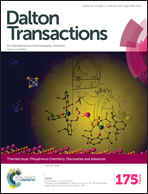P–S bond cleavage in reactions of thiophosphinidene-bridged dimolybdenum complexes with [Co2(CO)8] to give phosphinidene-bridged heterometallic derivatives†
Abstract
The thiophosphinidene complex [Mo2Cp2(μ–κ2:κ1,η6-SPMes*)(CO)2] (Mes* = 2,4,6-C6H2tBu3) reacted with [Co2(CO)8] at room temperature or below to give several of the following phosphinidene-bridged products, depending on reaction conditions: the MoCo complexes [CoMoCp(μ–κ1:κ1,η6-PMes*)(CO)3] and [CoMoCp(μ-PMes*)(CO)5] (Co–Mo = 2.972(1) Å), the MoCo3 cluster [Co3MoCp(μ3-PMes*)(CO)9] (Co–Mo = 2.664(1), 2.810(1) Å), and the sulphido-bridged tetranuclear complexes [Co2Mo2Cp2(μ–κ1:κ1:κ1,η4-PMes*)(μ3-S)(CO)7] and [Co3MoCp(μ–κ1:κ1:κ1,η4-PMes*)(μ3-S)(CO)8]. In contrast, the thiophosphinidene complex [Mo2Cp2(μ–κ2:κ1,η4-SPMes*)(CO)3] reacted with the same cobalt reagent selectively to give the above Mo2Co2 complex in very high yield. The latter could be decarbonylated photochemically to give [Co2Mo2Cp2(μ–κ1:κ1:κ1,η6-PMes*)(μ3-S)(CO)6] (Co–Co = 2.435(3), Co–Mo = 2.769(2), 2.798(2) Å), after an η4- to η6-haptotropic rearrangement of the aryl ring of the phosphinidene ligand that could be reversed upon reaction with CO. The related complex [Mo2Cp2(μ–κ2:κ1,η4-SPMes*)(CO)2(CNtBu)], however, displayed poor selectivity towards the cobalt dimer and yielded a mixture of CoMo complexes [CoMoCp(μ-PMes*)(CO)5] and [CoMoCp(μ-PMes*)(CO)3(CNtBu)2], and the tetranuclear sulphido-bridged ones [Co2Mo2Cp2(μ–κ1:κ1:κ1,η4-PMes*)(μ3-S)(CO)6(CNtBu)] (Co–Co = 2.533(1), Co–Mo = 2.7485(9), 2.770(1) Å) and [Co3MoCp(μ–κ1:κ1:κ1,η4-PMes*)(μ3-S)(CO)7(CNtBu)] (Co–Co = 2.4120(7) to 2.5817(7) Å). This reduction in selectivity might have an electronic origin rather than a steric origin, since the related but cationic substrate [Mo2Cp2{μ–κ2:κ1,η5-SP(C6H3tBu3)}(CO)2(CNtBu)]BAr′4 [Ar′ = 3,5-C6H3(CF3)2] reacted with [Co2(CO)8] more selectively to give the sulphido-bridged Co2Mo2 complex [Co2Mo2Cp2{μ–κ1:κ1:κ1,η5-P(C6H3tBu3)}(μ3-S)(CO)6(CNtBu)]BAr′4, along with small amounts of the Co3Mo complex [Co3MoCp{μ–κ1:κ1:κ1,η5-P(C6H3tBu3)}(μ3-S)(CO)7(CNtBu)]BAr′4 (Co–Co = 2.414(2) to 2.560(2) Å). The structure of the new complexes was analyzed on the basis of the corresponding X-ray diffraction and spectroscopic data, and likely reaction pathways were discussed on the basis of the above results and some additional experiments.
![Graphical abstract: P–S bond cleavage in reactions of thiophosphinidene-bridged dimolybdenum complexes with [Co2(CO)8] to give phosphinidene-bridged heterometallic derivatives](/en/Image/Get?imageInfo.ImageType=GA&imageInfo.ImageIdentifier.ManuscriptID=C5DT01450F&imageInfo.ImageIdentifier.Year=2016)
- This article is part of the themed collection: Phosphorus Chemistry: Discoveries and Advances

 Please wait while we load your content...
Please wait while we load your content...